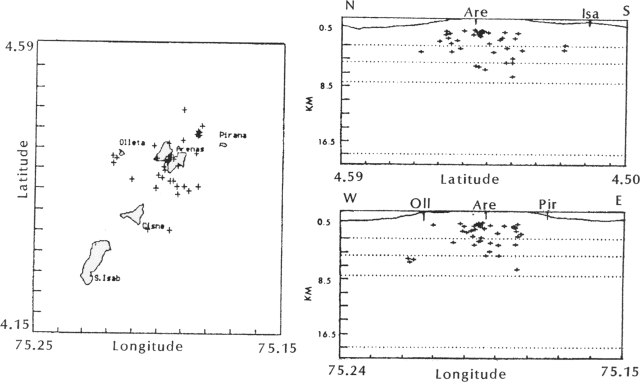Report on Nevado del Ruiz (Colombia) — May 1989
Scientific Event Alert Network Bulletin, vol. 14, no. 5 (May 1989)
Managing Editor: Lindsay McClelland.
Nevado del Ruiz (Colombia) High-energy seismic swarm
Please cite this report as:
Global Volcanism Program, 1989. Report on Nevado del Ruiz (Colombia) (McClelland, L., ed.). Scientific Event Alert Network Bulletin, 14:5. Smithsonian Institution. https://doi.org/10.5479/si.GVP.SEAN198905-351020
Nevado del Ruiz
Colombia
4.892°N, 75.324°W; summit elev. 5279 m
All times are local (unless otherwise noted)
A swarm of more than 500 high-frequency events on 13-14 May had the second highest energy release since telemetric monitoring began in 1985. Seismic energy release increased 3.5x during the swarm, centered <2 km below Arenas crater (figure 27). Brief pulses of low-energy tremor and a small number of long-period events were also recorded during the month. Deformation (dry and electronic tilt) was low. SO2 emissions continued to decrease, to an average of 1,046 t/d in May.
 |
Figure 27. Epicenters (left) and cross sections showing depths (right) of 44 seismic events at Ruiz, May 1989. Courtesy of the Observatorio Vulcanológico de Colombia. |
Geological Summary. Nevado del Ruiz is a broad, glacier-covered volcano in central Colombia that covers more than 200 km2. Three major edifices, composed of andesitic and dacitic lavas and andesitic pyroclastics, have been constructed since the beginning of the Pleistocene. The modern cone consists of a broad cluster of lava domes built within the caldera of an older edifice. The 1-km-wide, 240-m-deep Arenas crater occupies the summit. The prominent La Olleta pyroclastic cone located on the SW flank may also have been active in historical time. Steep headwalls of massive landslides cut the flanks. Melting of its summit icecap during historical eruptions, which date back to the 16th century, has resulted in devastating lahars, including one in 1985 that was South America's deadliest eruption.
Information Contacts: C. Carvajal, INGEOMINAS, Manizales.

